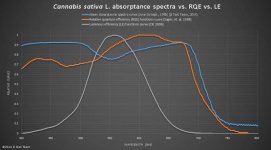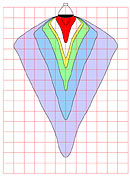Beta Test Team
Member
Here's a nice one.
This graph shows the mean of Cannabis absorptance from two tests in vegetative stage and two in flowering stage, each test was 3 to 5 weeks apart. That mean is compared to the RQE curve of higher plants (same as before), but this time we added the 2008 CIE luminous efficiency curve (which represents how human eyes use light).
More graphs to come.
[NOTE 10-7-2014: This graph is from older data that we have since adjusted slightly. This graph will be updated as we have time.]
This graph shows the mean of Cannabis absorptance from two tests in vegetative stage and two in flowering stage, each test was 3 to 5 weeks apart. That mean is compared to the RQE curve of higher plants (same as before), but this time we added the 2008 CIE luminous efficiency curve (which represents how human eyes use light).
More graphs to come.
[NOTE 10-7-2014: This graph is from older data that we have since adjusted slightly. This graph will be updated as we have time.]
Attachments
Last edited:









